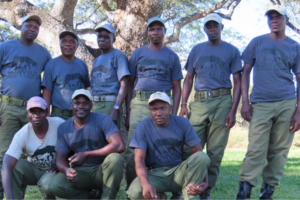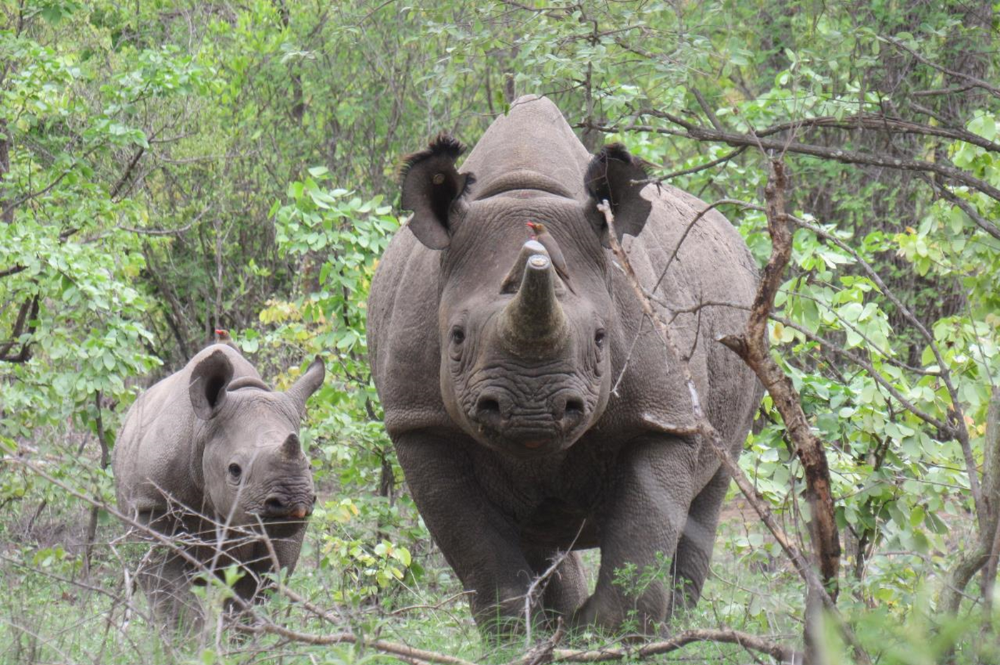With more than 1,000 rhinos, Zimbabwe is one of the top four countries in Africa when it comes to black (616) and white (417) rhino population sizes. However, despite recently reaching this milestone (the last official count was official at 31 December 2021), Zimbabwe’s rhinos were once found in far greater numbers.
Amidst the heights of the poaching crisis of the late 1980s and early 90s, guerrilla militants stationed in the Zambezi Valley deterred prospective poachers from illegally killing rhinos here. However, after rhinos became extinct in Zambia’s Luangwa Valley and following Zimbabwe’s independence in 1980, these militias moved out and the organised poaching networks moved in. Zimbabwe’s rhino population was reduced to approximately 450 by 1992.
To safeguard the remaining animals, the decision was made to move them to intensively protected conservancies in the south of the country. Through several extensive operations, ~300 rhinos were transported from the Zambezi to safer destinations, including the Save Valley Conservancy (SVC) and Bubiana Conservancy. Living in heavily protected yet idyllic habitats, these founding populations prospered, and their numbers grew.
Unfortunately, this was not to last. In 2002, the rhinos at Bubiana Conservancy needed a safe new home. They were soon moved, by the Lowveld Rhino Trust (LRT), to Bubye Valley Conservancy (BVC), a former cattle ranch turned wildlife conservancy. Whilst it had no rhinos at the time (as well as few lions, elephants and other wild species), in the little more than 20 years since, it has become one of the largest and most genetically diverse black rhino populations in Africa.
Since those early days, this population has been carefully monitored by LRT. Identifying each rhino via their individual ear notch numbering system, the Trust’s Rhino Monitors keep close tabs on each of animal, recording an accurate picture of the population’s dynamics and informing management decisions. Each month, the Trust aims to ID 80 different rhinos. With BVC covering more than 3,200km2, this is no easy task. Last year, despite the thick vegetation making visibility a challenge, the team achieved an impressive average of more than 160 IDs each month, supported by the use of camera traps and aerial IDs.
Monitoring in this way not only helps to ensure the health of each animal but also gives an early indication of whether poaching is having an impact on the population, as resultant disruptions to the rhinos’ social networks can cause them to cover greater distances. In un-notched populations, this can give the misleading impression that the population remains stable, as individuals and their spoor continue to be observed across vast areas. However, LRT’s ability to identify each animal and understand their social groups provides an accurate count of the true population size.

In 2023, thanks to support from the Anna Merz Rhino Trust, we were able to grant $25,000 to LRT in support of their important monitoring efforts. The funds were used to purchase uniforms for the Rhino Monitoring Unit (boots, trousers, shirts, overalls and jackets), pay for vehicle fuel and maintenance, provide food and accommodation for Task Force operatives, and pay informers for information on poaching networks working in the area.
Fortunately, poaching levels appear to be down in the Lowveld, thanks to the admirable work done by the Lowveld Rhino Law-Enforcement Task Force, and other stakeholders, to counter the threat. In fact, none of BVC’s rhinos are known to have been poached in 2023.
But challenges persist. Corruption continues to hamper law enforcement efforts and judicial processes.
Nonetheless, the numbers show efforts to protect Zimbabwe’s rhinos are making a difference. In 2023, just four white rhinos were poached in the country, none of which were in the Lowveld. BVC’s rhino population has continued to grow, supporting the reintroduction of other populations, such as rhinos going back to Gonarezhou National Park.
BVC is a symbol of incredible recovery and it is thanks to donors such as the Anna Merz Rhino Trust and others that this exciting progress has been possible. However, the threat to rhinos from poaching remains. South Africa saw a rise in poaching incidents during 2023 when it lost 499 animals, up from 448 the previous year. Poaching has even reached the island of Java, in Indonesia, where as much as one third of the Javan rhino population is thought to have been illegally killed. There is still much to do before Zimbabwe’s rhinos are out of the woods, but it appears that there is light on the horizon.








